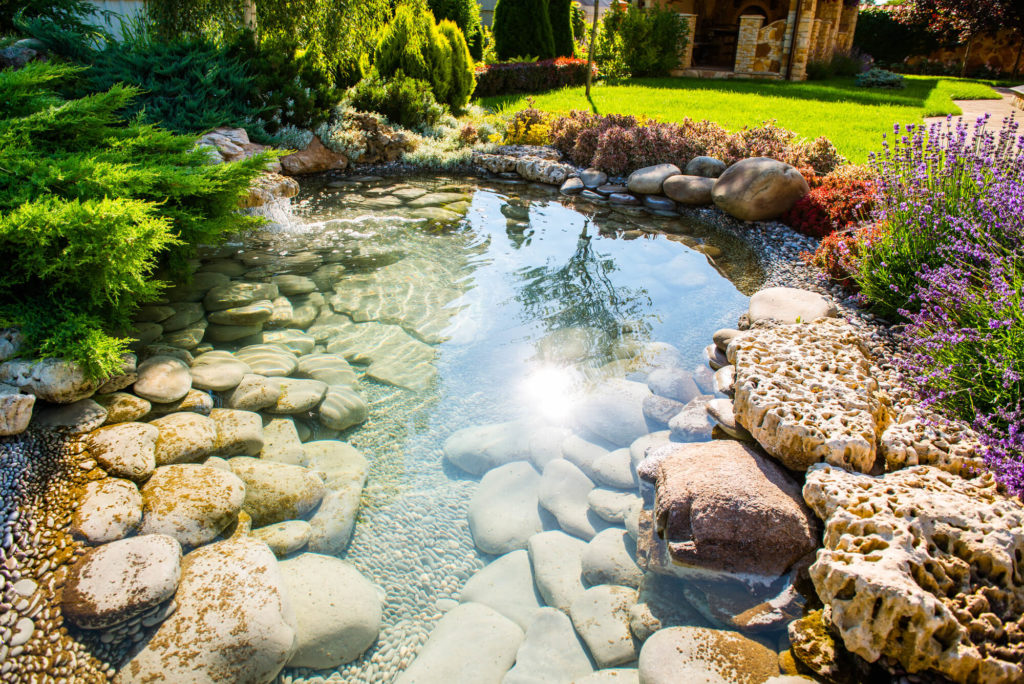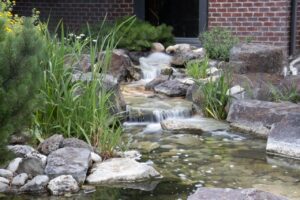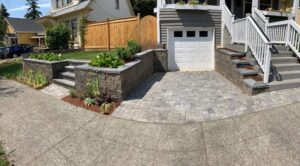Do you admire water gardens and wonder how to get one in your home? A water landscape isn’t difficult to implement if you know how.
In this post, we examine how to landscape with water providing the best water garden design ideas to suit your space and budget.
What Is Water Garden Landscaping?
Water gardening involves growing plants that thrive in rivers, lakes, and ponds. A water landscape can reach almost any depth or size. Typically, water landscaping includes submerged, floating, and edge plants such as American frogbit, water hyacinth, water lilies, and duckweed.

Water Garden Landscaping Ideas
Below are some excellent water garden ideas for your home.
A Sloping Stream
To achieve this most simple of pond decoration ideas, use visually unique plants and materials which gently move the eye downward. Excellent choices include ornamental grasses and weeping willow. Install different-sized boulders for edging the pond and add vibrant water lilies and black-eyed Susans for color and structure.
Dressed-Up Fountain
This distinctive water landscape includes paved landings and stone steps, lending formality to the central water feature—the fountain. Add ornamental grass, ivy, hydrangea, and other brightly colored plants to make the water garden pop against the stonework, along with bright purple lobelia in urns to create structure.
Circle ‘Round
This minimalist water feature highlights repetition with multiple circles unifying everything. Install a gravel path leading to a gently bubbling pond. Add plants such as liriope to echo the hardscape’s shape.
Focus on the Fountain
This garden waterfall design focuses on the fountain. Plant begonias and caladium to highlight the stonework. A topiary myrtle pair adds structural variety.
Pond Perfect
Place a simple bench or a table and chair overlooking an expansive, colorful lily pond. Add an arched bridge to welcome visitors to the water. Install various boulders around the pond’s edges for structure and visual interest.
Japanese Garden Inspiration
The Japanese initiated unique ponds landscaping ideas. Install this water landscape with prominent water features, a gurgling fountain, and an inviting bench to create your Asian-inspired getaway. Plant Japanese maple, rhododendron, and clumping bamboo for an authentic Zen feel; use steppingstones for access.
Wonderful Waterfall
Set shade-loving plants and evergreens around a backyard pond to create this water landscape. Use arborvitae as an evergreen softscape fence, stacked for edging and structure. Add a cascading water feature tumbling into a pond for visual and audio interest.
Advantages of Water Garden Landscaping
Key advantages of installing a water landscape include:
- Enhanced curb appeal and property value.
- Peaceful, relaxing atmosphere.
- Reduced outside noise, especially in the city.
- Excellent therapeutic tool: calms anxiety and lowers blood pressure.
- Increased harmony with nature through water sounds.
Call Today to Get Your Free Quote!
At New Life Rockeries, we have been helping homeowners in the Pacific Northwest improve their outdoor spaces with high-quality landscaping services for more than 35 years.
Contact us to learn more about our landscaping contractor and water garden services. Let us help you implement desired Water Garden Landscaping Designs.



